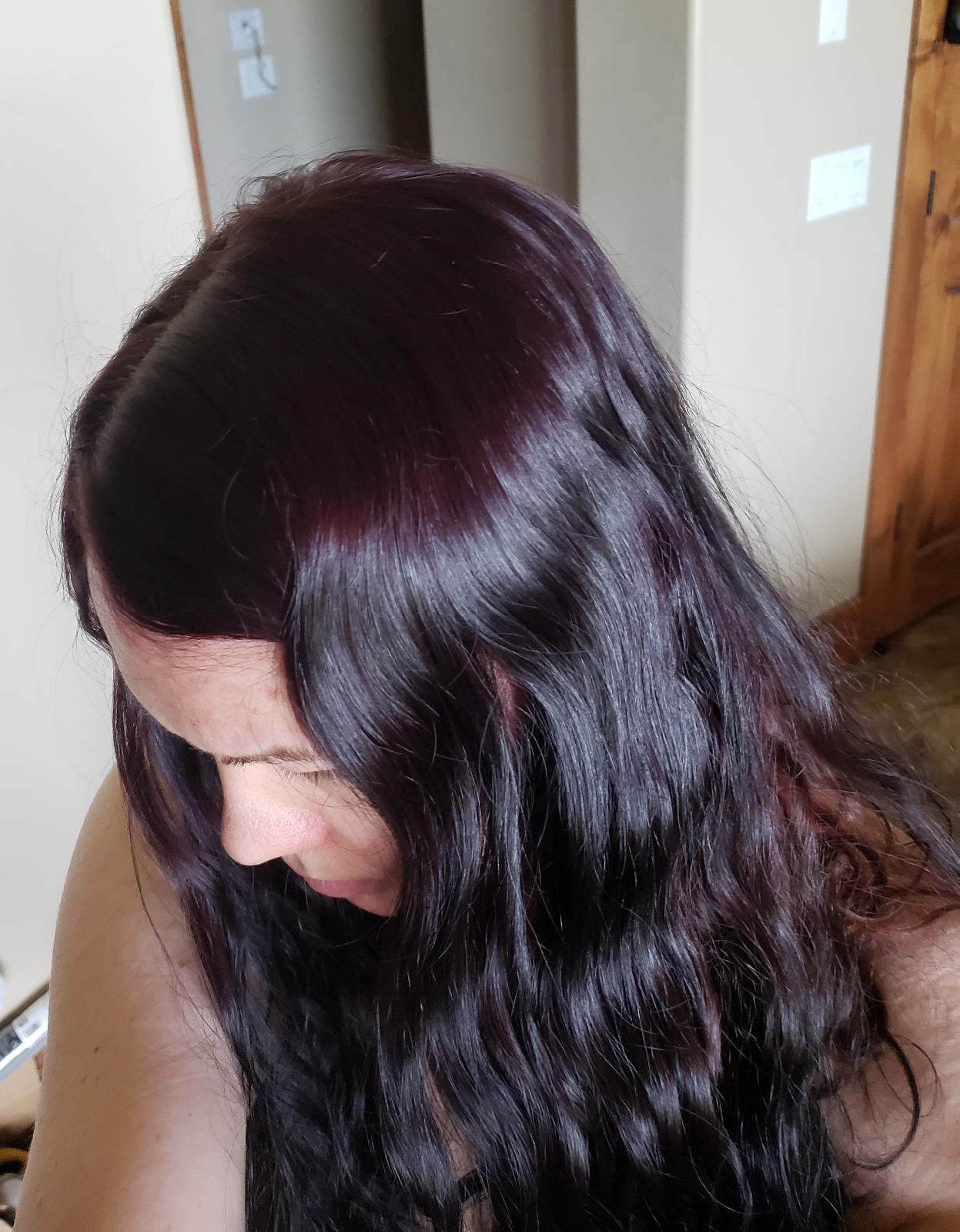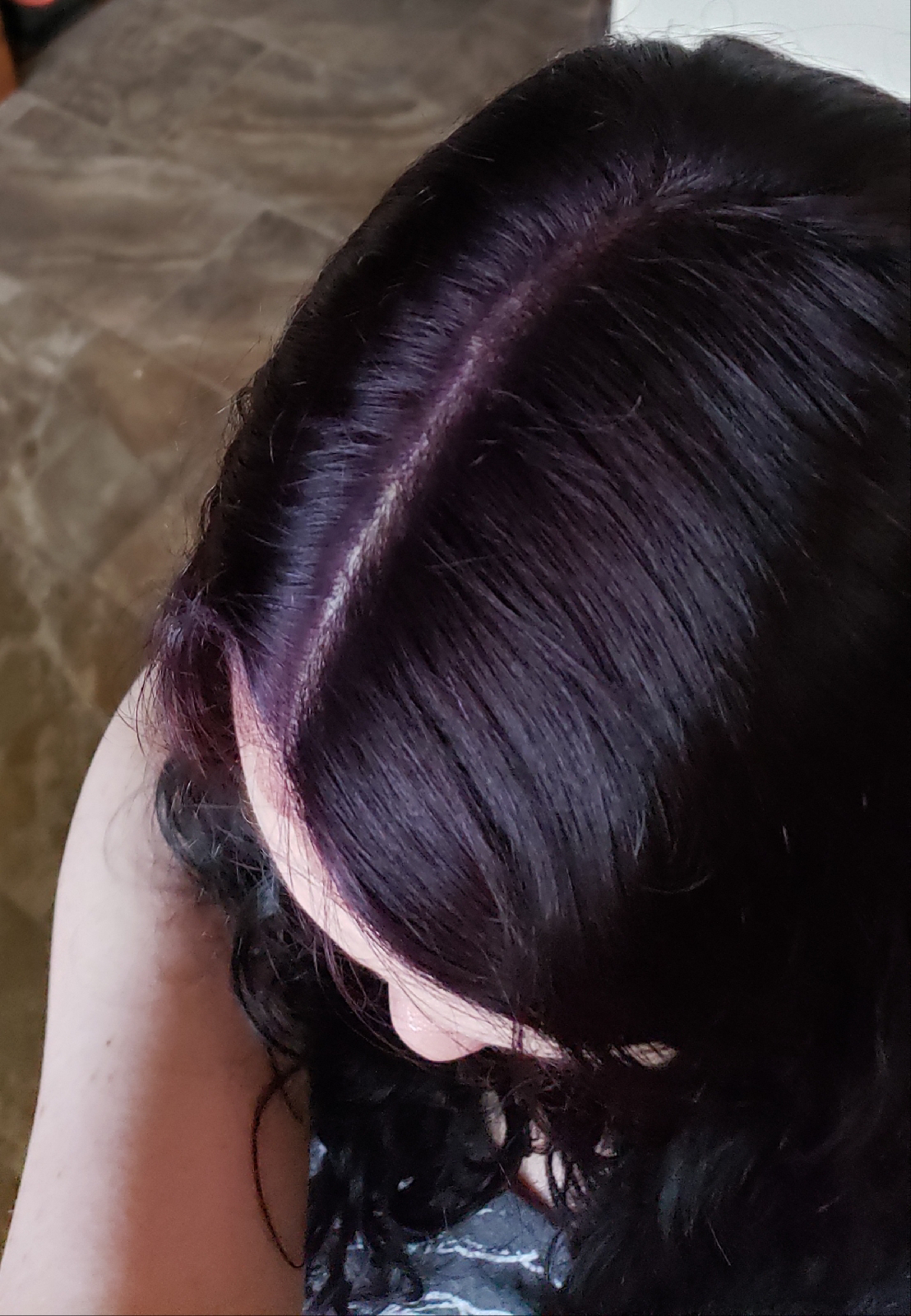Original Method for Reddish Purple (Natural Eggplant Hair Color with Henna & Logwood)
Note that I have a new favorite method, which you can find here. First, here are some images.
After the first wash = residue removed. It will stay at this color.
This is the easiest method because it's an all-in-one henna and logwood mix. It was recommended to me on an FB group by someone who has used it for years. I've adapted it for making a logwood infusion, then using the liquid to wet the henna. Using an infusion is better than using the logwood powder directly on your hair because the tiny wood pieces swell to a larger size and become difficult to rinse out. And I added my alum after-soak option for greater permanence (and keeping it pink-purple rather than letting it turn red with time), but some find this step unnecessary. Omit, if you prefer. DO NOT add aloe to this mix as it seems to deactivate the logwood. A small amount of guar or acacia gum keep the ingredients more compatible and retains moisture. If you have difficulty getting your roots dark enough this way, you may need to do a prior henna application as the logwood may require more in order to stick (2-step). Greys will turn out peachy purple when there's enough henna attached.
EDIT: I'm thinking about dye releasing the henna separately with as little water as needed to fully wet it, before adding the logwood liquid. The reason is that alkaline conditions inhibit henna dye release, which we don't want.
Ingredients:
50/50 henna to logwood powders by volume (I use 2/3 cup each.) Buy logwood powder either on Etsy or Amazon. [EDIT: Consider adding sidr to protect hair from the drying/damaging effects of this alkaline mix. Those allergic to latex might not be able to use sidr due to its wax's similar molecular structure.]
Distilled or reverse osmosis water without added minerals (I use 1.75-2 cups.)
Baking soda - Use 1 Tbsp per every 100g of logwood powder (which weighs 4g/tsp) (I use 1 Tbsp plus 0.81 tsp.)
Guar or acacia gum (optional thickening/moisture retention) (I use 1/8 tsp.)
Alum after-soak (optional step to permanently keep it purplish):
1 tsp alum powder (potassium aluminum sulfate) (Or 2/3 tsp aluminum sulfate)
1/2 tsp baking soda (here to ph balance the after-soak, since alum is very acidic on its own)
1/3 tsp guar gum (ideally, disperse into glycerin)
1/2 cup warm water
Directions:
- Place logwood powder into disposable paper teabags and put them in a pot with the distilled or RO water. (Alternatively, you could strain it after boiling with a coffee filter or 30 mesh strainer.)
- Boil for 10 min and turn off the heat. Remove teabags or strain into your mixing bowl (choose non-plastic for health reasons).
- Use a touchless thermometer to make sure that the liquid's temperature has dropped below 176 F. (Or just wait a couple minutes.)
- Add the baking soda and stir well. It'll turn from dark orange to purple.
- Combine the liquid with your henna powder in your mixing bowl until it has a yogurt-like consistency. If you need more water, put it in your logwood pot first so it picks up more logwood dye on the way in. If your mix looks too watery, gradually stir in a little guar gum until thickened as you like.
- Apply immediately with gloves on and cover your head when done. (An oversized silicone swim cap with winter hat on top for warmth is my method lately.)
- Leave on for 3 hours. (I've found that 4 hours isn't any better.) Drink licorice tea if you get tannin headaches from henna, assuming you don't have high blood pressure.
- While you're waiting, prepare your alum after-soak, which will ensure permanence or the purple tone (optional).
In a cup or jar, add 1/2 cup warm water (about 120-140 F) and then, with the stove fan running, add the alum and baking soda. Do not breathe in the sulfur dioxide gas that escapes; it's not dangerous but can exacerbate asthma symptoms.
Place guar gum powder into a large measuring spoon and mix it with enough glycerin to completely cover/disperse all powder particles. Add it to the cup/jar and use an electric mixer to thicken (or shake vigorously). Set aside for your shower.
- Rinse out your hair and apply the alum after-soak, taking care to reach your roots and avoid mouth and eyes. (Alum is safe for skin because it isn't absorbed, but don't ingest it.) Leave this in for 20 minutes while you shave your legs, etc. I like to keep my hair up in a clip while it processes.
- Rinse and use a deep conditioner to counteract the drying effect of baking soda. (Note that the alum after-soak is mildly acidic, so it will have already rebalanced your hair's ph.)
To keep the purple color, avoid hydrogen peroxide, chlorine, bleach, salt, highly acidic mixes, coconut oil, shea butter, most other oils, and all butters. However, you can use jojoba, rice bran oil, daikon seed extract oil, Abyssinian oil, and cucumber seed oil, which don't penetrate hair and, therefore, don't remove the color.
Disclaimer: I take no responsibility for any adverse reactions or health issues that appear to result from any methods or ingredients described in this blog or on my Facebook posts. While they all should be safe based on my research, unexpected reactions may occur. Try at your own risk.
In case you're curious, this is the "before photo." I have naturally dark blond hair, which had henna applied to it a couple months before using this mix. Again, recall that the bottom still has leftover indigo dye that I'm growing out.






Comments
Post a Comment